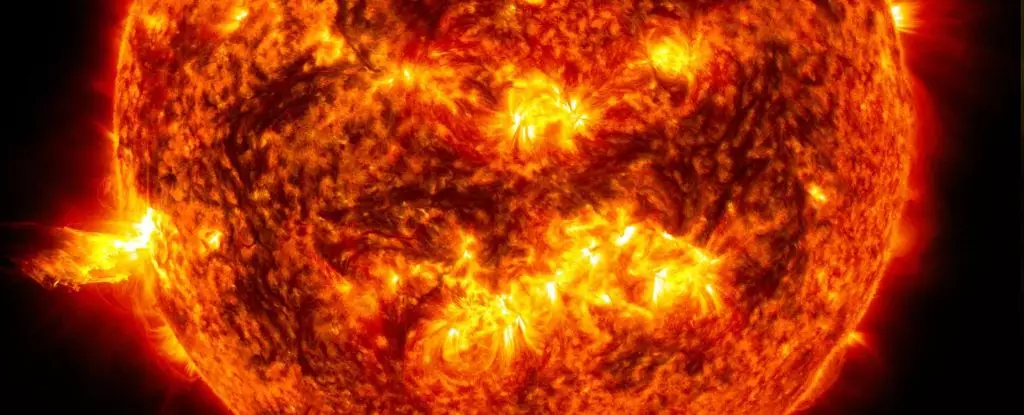For centuries, humanity has gazed skyward, trusting in the Sun’s comforting regularity. We’ve come to see it as a dependable star, a celestial clock ticking with predictable 11-year cycles. Yet, beneath this veneer of stability lies an underlying chaos—a dynamic, tempestuous engine driven by forces we still struggle to comprehend. Recent revelations challenge the assumption that the Sun’s activity abides strictly within this predictable rhythm. Instead, emerging evidence suggests that the Sun might be awakening from a long slumber, potentially heralding a new era of intensified solar phenomena.
The popular narrative has long held that solar activity ebbs and flows in modest cycles—peaks marked by sunspots, solar flares, and magnetic upheavals, followed by lulls. However, recent data paints a different picture. The Sun’s behavior since 2008 shows a steady escalation in the strength and intensity of its turbulence, defying earlier forecasts of a subdued solar period. This escalation isn’t subtle—it’s a clear sign that the solar engine is revving up, with consequences that extend far beyond the realm of astronomy.
What’s remarkably concerning is the disconnect between these newfound trends and traditional solar cycle models. Scientists expected Solar Cycle 25 to be relatively weak, aligning with the subdued activity of its predecessor, Solar Cycle 24. Instead, the Sun has surprised experts, exhibiting vigor and volatility reminiscent of more active periods. This discrepancy indicates that our current understanding of solar dynamics is incomplete at best, and dangerously optimistic at worst. Humanity’s dependence on technologies vulnerable to solar storms—satellite operations, power grids, navigational systems—raises urgent questions about how prepared we truly are for the Sun’s unpredictable behavior.
The Hidden Forces Powering the Sun’s Escalation
The Sun is more than a ball of gas; it’s a complex magnetohydrodynamic system in a constant state of flux. While surface phenomena like sunspots and solar flares are visible indicators, the real drivers of solar activity occur deep within its turbulent interior. The recent studies point to a significant rise in the strength of the solar wind—a continuous outflow of charged particles—that began around 2008 and shows no signs of stabilizing.
This intensification encompasses parameters such as wind speed, density, temperature, and magnetic field magnitude. Each aspect of this growth hints at a powerful internal engine awakening, potentially fueled by processes operating on timescales longer than the familiar 11-year cycle. What’s unsettling is that these long-term trends—observed over decades—are difficult to interpret, let alone predict. They remind us that the Sun’s behavior isn’t merely a cyclical pattern but involves deeper, longer cycles potentially spanning generations.
The Hale cycle, which describes a full 22-year magnetic polarity reversal, adds another layer of complexity. Current data suggest that the Sun’s magnetic system might be shifting into a phase of heightened activity associated with this longer cycle. If true, we are perhaps standing at the precipice of an extended period marked by more intense and erratic solar phenomena, with profound implications for Earth and human technology.
The Implications of a Reawakening Solar Power
The broader implications of these findings are profound. The potential escalation in solar activity threatens to unleash more frequent, powerful solar storms capable of severely disrupting our technological infrastructure. Power grids could buckle under the strain of massive geomagnetic disturbances, satellites could suffer more frequent outages, and communication networks might face unprecedented challenges.
Moreover, this unpredictability underscores a fundamental flaw in our approach to understanding the Sun. For decades, scientists relied heavily on sunspot counts and short-term patterns to forecast solar activity. Now, it’s clear that these indicators only provide a fragmentary view, missing the deeper, long-term processes that govern solar behavior. The increasing magnetic and kinetic energies inside the Sun’s core hint at a much richer tapestry of solar dynamics—one that demands more comprehensive observation and modeling.
If the Sun is indeed awakening from a prolonged period of quiescence, as data seems to suggest, then we are facing a future where solar storms might become commonplace rather than rare anomalies. This isn’t merely a cosmic curiosity; it’s a clarion call for humanity to rethink how we prepare for space weather. Our technological society is vulnerable, and the awakening of the Sun’s hidden power could test our resilience in ways we are only beginning to understand.
Ultimately, the evolving picture of solar activity serves as a warning: the Sun is not merely a passive star providing life’s energy but an active, unpredictable force that we must continue to study, understand, and respect. Its next move could redefine our technological stability and challenge the very fabric of our modern civilization. As we track these ominous signs, it becomes evident that our relationship with the Sun demands nothing less than vigilant scrutiny and adaptive resilience.

